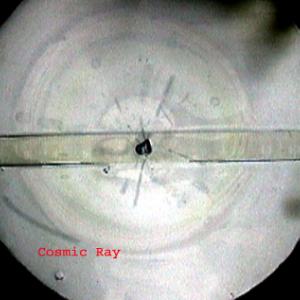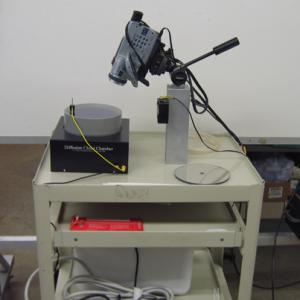College of Liberal Arts & Sciences
7D10.80 - Cosmic Rays
See also 7D10.80 in Modern Physics.
The chamber should be set up as described in the manual in the file. Care should be taken to insure that the black plate in the chamber is level. The chamber is attached to a leveling stand with Velcro so that this may be done. Turn the fluorescent light on as soon as possible or the ballast may get to cold to activate. Place the camera as shown over the glass window in the top plate. Close-up lenses are not needed if you use the macro part of the lens on the camera. The ion trails should appear in 5 to 15 minutes after the final step of activation and last for several hours.
- Jeffrey D. Goldadaer and Seulah Choi, "An Inexpensive Cosmic Ray Detector for the Classroom", TPT, Vol. 48, #9, Dec. 2010, p. 594.
- W. Brouwer, J. Pinfold, R. Soluk, B. McDonough, V. Pasek, and Zheng Bao-shan, "Student Projects in Cosmic Ray Detection", TPT, Vol. 47, #8, Nov. 2009, p. 494.
- Henry Muhry and Patric Ritter, "Muons in the Classroom", TPT, Vol. 40, #5, May. 2002, p. 294.
- Pierre Soklosky, "The Fly's Eye Detector", TPT, Vol. 23, #4, Apr. 1985, p. 207.
- Serge A. Korff, "Cosmic Rays and Eclipses", TPT, Vol. 13, #6, Sept. 1975, p. 333.
- Martin A. Pomerantz, "Gadabouts of the Universe", TPT, Vol. 2, #8, Nov. 1964, p. 355.
- Luisa Bonolis, "Walther Bothe and Bruno Rossi: The Birth and Development of Coincidence Methods in Cosmic-Ray Physics", AJP, Vol. 79, #11, Nov. 2011, p. 1133.
- Matteo Leone, "Particles That Take Photographs of Themselves: The Emergence of the Triggered Cloud Chamber Technique in Early 1930s Cosmic-Ray Physics", AJP, Vol. 79, #5, May 2011, p. 45.
- David P. Jackson and Matthew T. Welker, "Measuring and Modeling Cosmic Ray Showers with an MBL System: An Undergraduate Project", AJP, Vol. 69, #8, Aug. 2001, p. 896.
- Qiaozhen Xu and Laurie Brown, "The Early History of Cosmic Ray Research", AJP, Vol. 55, #1, Jan. 1987, p. 23.
- J. R. Winckler and D. J. Hofmann, "Resource Letter CR-1 on Cosmic Rays", AJP, Vol. 35, #1, Jan. 1967, p. 2.
- R. U. Abbasi et al, "Extremely Energetic Cosmic Rays from a Preferred Direction", Physics Today, Vol. 67, #9, Sept. 2014, p 16.
- Bernard Degrange, Gérard Fontaine, and Patrick Fleury, "Tracking Louis Leprince-Ringuet's Contributions to Cosmic-Ray Physics, Physics Today, Vol. 66, #6, June 2013, p. 8.
- Bertram Schwarzschild, "Gamma-Ray Spectra Show That Supernova Remnants Create Cosmic-Ray Protons", Physics Today, Vol. 66, #4, Apr. 2013, p. 14.
- Per Carlson, "A Century of Cosmic Rays", Physics Today, Vol. 65, #2, Feb. 2012, p. 30.
- Bertram Schwarzschild, "Balloon Experiment Reveals a New Way of Finding Ultrahigh-Energy Cosmic Rays", Physics Today, Vol. 63, #12, Dec. 2010, p. 22.
- Bertram Schwarzschild, "The Highest-Energy Cosmic Rays May be Iron Nuclei", Physics Today, Vol. 63, #5, May 2010, p. 16.
- Bertram Schwarzschild, "Gamma-Ray Telescopes Show Origins of Cosmic Rays", Physics Today, Vol. 63, #12, Jan. 2010, p. 13.
- F.-Y. Chang et al., "Plasma Waves and Cosmic Rays", Physics Today, Vol. 62, #5, May 2009, p. 22.
- "Highest-Energy Cosmic Rays", Physics Today, Vol. 61, #10,Oct. 2008, p. 25.
- Bertram Schwarzschild, "The Highest-Energy Cosmic Rays Appear to Come From Nearby Active Galactic Nuclei", Physics Today, Vol. 61, #1, Jan. 2008, p. 17.
- Bertram Schwarzchild, "Varying Cosmic-Ray Flux May Explain Cycles of Biodiversity", Physics Today, Vol. 60, #10, Oct. 2007, p. 18.
- Bertram Schwarzschild, "Fluorescence Telescope Observe the Predicted Ultrahigh-Energy Cutoff of the Cosmic-Ray Spectrum", Physics Today, Vol. 61, #5, May 2007, p. 17.
- Juan G. Roederer, "Early Cosmic-Ray Research in Argentina", Physics Today, Vol. 56, #1, Jan. 2003, p. 32
- Peter Meyer, Reuven Ramaty, and William R. Webber, "Cosmic Rays - Astronomy with Energetic Particles", Physics Today, Vol. 27, #10, Oct. 1974, p. 23.
- Isaac Asimov, "Into the Here", Fantasy and Science Fiction Magazine, p. 138.
- Isaac Asimov, "Out of the Everywhere", Fantasy and Science Fiction Magazine, p. 129.
- James A. Van Allen, "On the Modulation of Galactic Cosmic Ray Intensity During Solar Activity Cycles 19, 20, 21, 22 and Early 23", Geophysical Research Letters, Vol. 27, # 16, Aug. 15, 2000, p. 2753 - 2456.
- James A. Van Allen and Bruce A. Randall, "A Durable Reduction of Cosmic Ray Intensity in the Outer Heliosphere", Journal of Geophysical Research, Vol. 102, # A 3, Mar. 1997, p. 4631 - 4641.
- J. A. Van Allen, "Observed Solar Modulation of Galactic Cosmic Ray Intensity in the Outer Heliosphere, 1997-2001", Geophysical Research Letters, Vol. 29, #7, 2002, p. 35-1.
- George H. Ludwig, "The First Explorer Satellites", prepared for Van Allen's 90thBirthday Celebration At the University of Iowa, 9 October 2004.
- Tom Petruzzellis, "Space Radiation", Electronic Sensors for the Evil Genius, p. 247.
- This Month in Physics History, "February 6, 1970: Luis Alverez's Paper Science on Cosmic Rays and Pyramids", APS News, Vol. 28, #2, Feb. 2019, p. 2, 6.
Disclaimer: These demonstrations are provided only for illustrative use by persons affiliated with The University of Iowa and only under the direction of a trained instructor or physicist. The University of Iowa is not responsible for demonstrations performed by those using their own equipment or who choose to use this reference material for their own purpose. The demonstrations included here are within the public domain and can be found in materials contained in libraries, bookstores, and through electronic sources. Performing all or any portion of any of these demonstrations, with or without revisions not depicted here entails inherent risks. These risks include, without limitation, bodily injury (and possibly death), including risks to health that may be temporary or permanent and that may exacerbate a pre-existing medical condition; and property loss or damage. Anyone performing any part of these demonstrations, even with revisions, knowingly and voluntarily assumes all risks associated with them.

